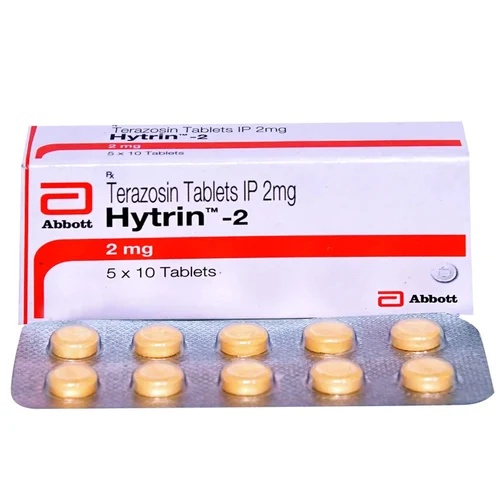Instructions for Terazosin

Instructions for Terazosin
Terazosin is a medication commonly used in the treatment of hypertension and benign prostatic hyperplasia. As a selective α1-adrenergic receptor antagonist, its main mechanism of action is to relax and dilate the muscles of blood vessels, allowing more blood to flow smoothly, thereby achieving the goal of lowering blood pressure. At the same time, Terazosin also has a good therapeutic effect on patients with hypertension accompanied by prostatic hyperplasia, and can improve the urinary flow disorders caused by prostatic hypertrophy in men. This article will provide a detailed introduction to the indications, dosage, adverse reactions, and precautions of Terazosin.
I. Indications
Terazosin is mainly used in two areas of treatment. Firstly, it is widely used to control hypertension, reducing the risk of cardiovascular diseases by lowering blood pressure. Secondly, it is also suitable for the treatment of benign prostatic hyperplasia, helping to relieve symptoms such as frequent urination, urgency, and difficulty in urination caused by prostatic hyperplasia. Based on professional medical judgment, Terazosin can be used alone or in combination with other antihypertensive drugs to achieve better therapeutic effects.
II. Dosage
Terazosin is administered orally. Patients are generally advised to take it before going to bed because when initially taking the drug, it may cause symptoms such as dizziness or fainting. Taking it before bedtime can reduce the impact of these discomforts on daily life to a certain extent. The initial dose is usually 1mg. Subsequently, the doctor will gradually increase the dose according to the patient's response to the drug. Generally, the maximum dose is 10mg. During the process of taking the medication, patients must strictly follow the doctor's instructions and not randomly increase or decrease the dose to avoid adverse reactions.
III. Adverse Reactions
Although most patients tolerate Terazosin well, some may still experience adverse reactions. Common side effects include headache, dizziness, fatigue, nausea, and nasal congestion. Some patients may have more serious reactions such as low blood pressure, palpitations, or blurred vision. If patients experience obvious discomfort or adverse reactions during the medication process, they should promptly contact medical staff for appropriate handling.
IV. Precautions
When using Terazosin, there are many situations that require special attention. Patients with severe liver or kidney insufficiency should use this drug with caution, and the dose may need to be adjusted if necessary. Before starting the medication, patients should inform the doctor in detail about all their previous medical histories and other medications they are taking to avoid potential drug interactions. In addition, Terazosin may affect a patient's ability to drive or operate machinery. Therefore, patients are advised to avoid these activities that require high concentration and quick reaction in the initial stage of taking the drug.
As an important therapeutic drug, Terazosin plays a significant role in the treatment of hypertension and prostatic hyperplasia. When using it, patients must strictly follow medical advice and pay close attention to possible adverse reactions to ensure the safety and effectiveness of medication. If necessary, you can consult the Dingxiang customer service.
The following are several case Q&A to help you better understand the use of Terazosin:
Question: I have both hypertension and prostatic hyperplasia. Can taking Terazosin improve both conditions simultaneously?
Answer: As a selective α1-adrenergic receptor antagonist, Terazosin can lower blood pressure by relaxing blood vessel smooth muscles and improve urinary flow disorders caused by prostatic hypertrophy. Therefore, for patients with both hypertension and prostatic hyperplasia, taking Terazosin under the guidance of a doctor may improve both conditions at the same time. However, the specific effect may vary from person to person. It is recommended to have regular follow-up visits to observe the treatment effect.
Question: I just started taking Terazosin at a dose of 1mg and feel a bit dizzy. Is this normal? What should I do?
Answer: When initially taking Terazosin, dizziness is a relatively common adverse reaction in some patients. This is because the drug may cause a drop in blood pressure, affecting blood supply to the brain. It is recommended that you continue to observe the symptoms. If the dizziness is mild and gradually subsides, you can continue to take the medication as prescribed. But if the dizziness persists or worsens and affects daily life, contact your doctor in a timely manner. The doctor may adjust the dose or provide other suggestions based on the situation.
Question: I have mild liver insufficiency. Can I take Terazosin?
Answer: Patients with liver insufficiency need to be cautious when using Terazosin. Mild liver insufficiency does not necessarily mean that the drug cannot be used at all, but you must inform the doctor about your liver function condition before use. The doctor will comprehensively evaluate your condition to determine whether the drug is suitable and whether the dose needs to be adjusted. During the medication process, you also need to pay close attention to your physical reactions and have regular liver function check-ups to ensure the safety of medication.

